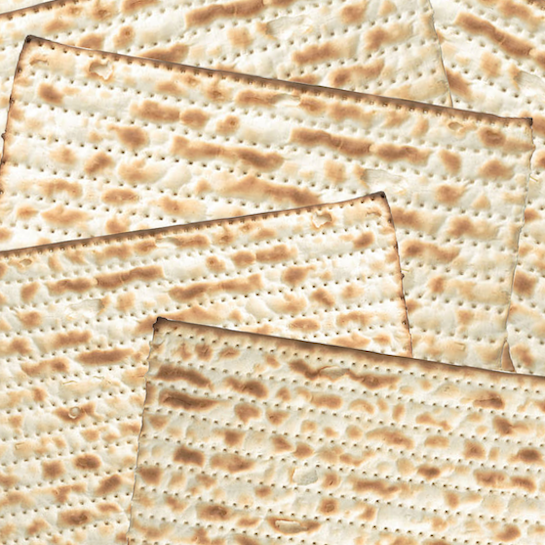
I’m the child of parents with different religious backgrounds, so I got to celebrate
all of the big holidays growing up. While I’ve written before about how to me Christmas and Chanukah are one big Festival of Lights, a time of peace largely secular and yet powerfully spiritual, it’s Passover and Easter that have much more in common from both liturgical and historical perspectives. Just about the only connection besides their calendar proximity to me as a kid was searching for the afikoman during Passover and hunting for candy on Easter Sunday, but later on I got hip to the whole “paschal lamb” metaphor and had my mind blown when I discovered that Jesus’s Last Supper was a Passover seder and the original communion wafers were matzah (מַצָּה).
Afikoman is not the name of a Jewish superhero. It’s pronounced “ah-fee-koh-min”
and is a piece of matzah — the unrisen bread eaten during Passover to recall the rushed exodus of the Hebrew people from Egypt — hidden for children to find at a ritual dinner known as the seder (“say-dur”) is concluded. You may also see “matzah” spelled “matzo” above (or “matza” or “matzoh” for good measure); still, it’s pronounced “maht-zuh” in English and “maht-zah” in Hebrew, not “maht-zoh” (although the plural in Hebrew is pronounced “maht-zoht”) — unless you’re eating some, in which case you can’t say anything because your mouth is utterly devoid of saliva with flecks of the driest cracker known to humanity stuck everywhere.
Traditional matzah is about eight inches square and extremely flat as well as dry. It’s sold in salted and unsalted varieties, sometimes made with egg, sometimes flavored with onion, and in broken-up form or as powdered matzah-meal ready for use in baking cakes that will be kosher l’pesach, or kosher for Passover, since normal leavening agents can’t be used. While extremely dry on its own it’s easily moistened with egg and water to cook as fried matzah or matzah brei, sort-of like French toast, and during the eight days of Passover it’s often the basis of a variation on pizza or eaten with peanut butter and jelly or honey. You’ll even find matzah sold covered in chocolate, but in my house you could just take a bite of regular matzah from one hand and chomp on a chocolate bunny from the other.
Related: I Melt with You • The Dark of the Covenant • Why Is This Joke
Different From All Other Jokes? • Braids of Glory • Nick of Time

Happy Easter, Blam!
ReplyDeleteI thought Matzah was like...a dough ball thing in soup. Matzah ball, right? I am glad to see you back :)
Hi Blam
ReplyDeleteGlad to see you're back.
It must have been very interesting growing up getting exposed to more than one religion. I think that being able to experience events and life with more than one perspective is very cool.
I admit, that I am like Joan. I also thought Matzah was a ball, or a braided bread? I had no idea it was cracker! An apparently, very dry, cracker:P
Happy Passover/Resurrection Sunday!
ReplyDeleteunless you're eating some, in which case you can't say anything because your mouth is utterly devoid of saliva with flecks of the driest cracker known to humanity stuck everywhere.
Ain't that the truth!
We've started having a Seder every year at our church and it is such a wonderfully rich experience. (We also use real Matzah for communion)
Good to see you here again!
This comment has been removed by the author.
ReplyDeleteLOL!
ReplyDeleteNo, really, the "driest cracker" line was hysterical — as were "¿quien es más matzah?" and "afikoman is not a Jewish superhero". This is the humor that must not be silenced!
I grew up mixed like Blam and, despite growing up in a community with few other Jews, am still surprised at how little non-Jews are aware of Jewish traditions, just as I'm surprised at how little sympathy many Jews have for my desire to continue traditions from the Christian side of my family even though religiously I've chosen to practice Judaism and raise my kids in that faith; I don't want them, or me, to forget our other roots.
Matzah balls, Joan and Jenn, are indeed spongy doughballs in soup, but they are made from matzah meal that comes from the flat, unleavened stuff we eat at the seder and throughout the week. It's like how meatballs come from meat but aren't really reflective of the ground beef from which they're formed or the side of beef that that came from. Matzah itself is generally a big, maybe 8' x 8' cracker.
The braided braid that you're thinking of, Jenn, might be challah, which is traditionally Jewish bread made and served at Friday-night sabbath dinners throughout the year.
I think it's awesome that your church puts on a seder, Sonshine Music.
Happy Easter and Passover to everybody!
Yo soy más matzah!
ReplyDeleteWait... Do they make soy matzah?